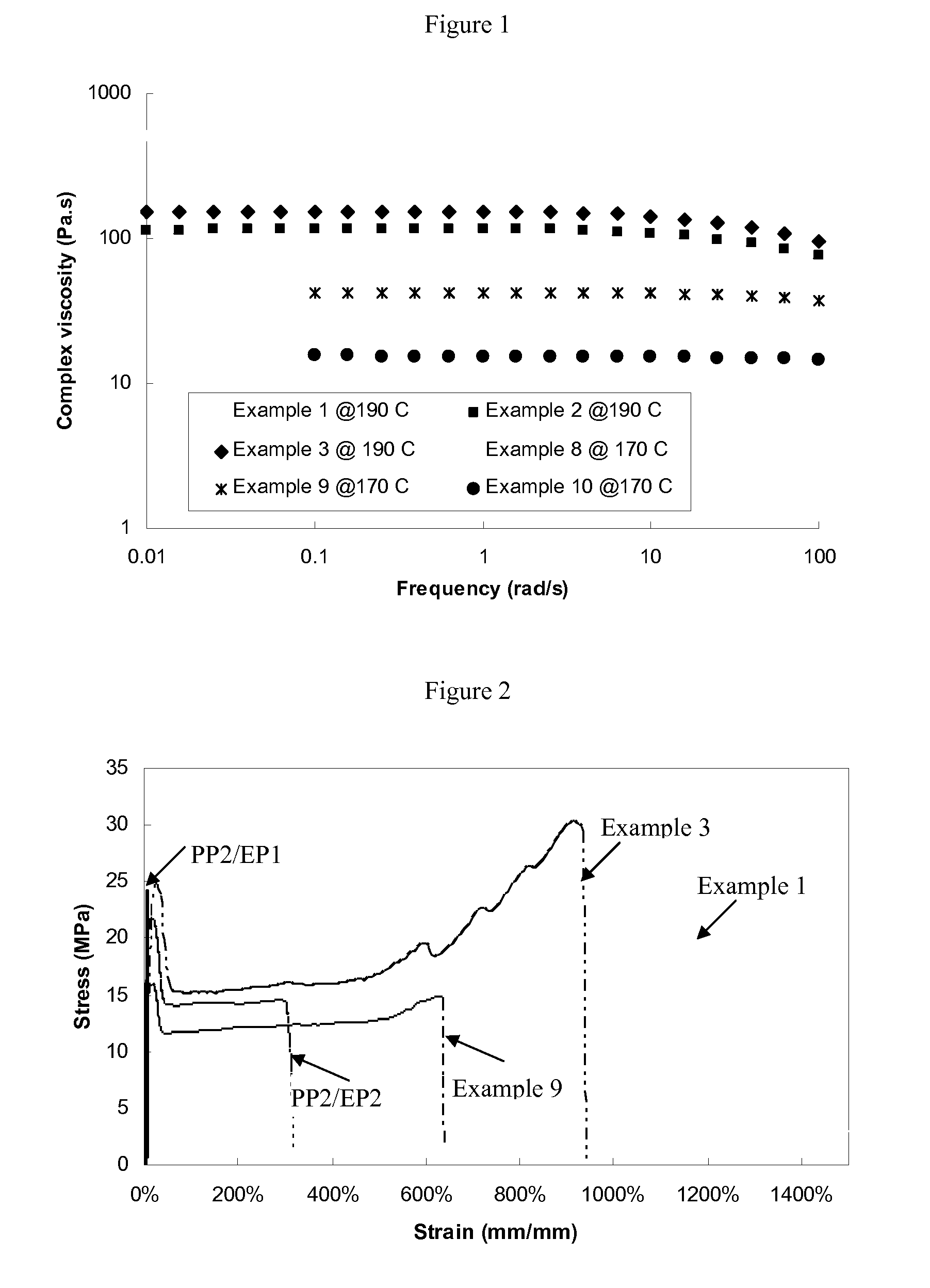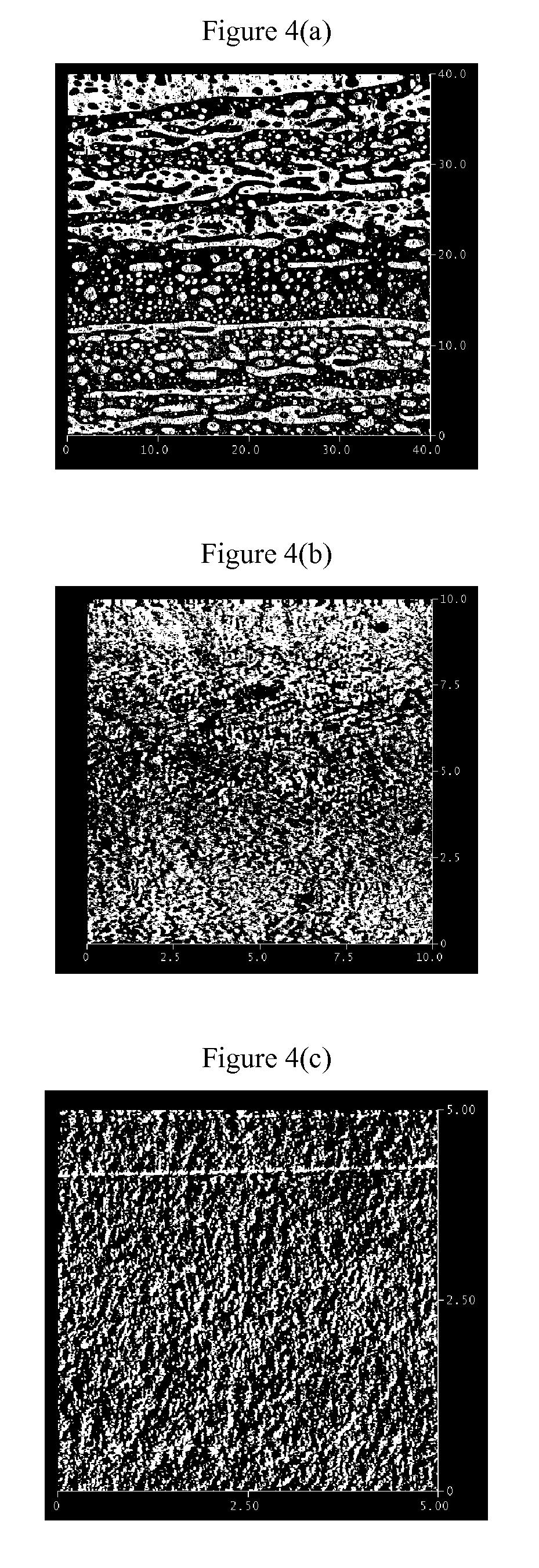Thermoplastic olefin compositions
a technology of olefin composition and thermoplastic, which is applied in the field of thermoplastic olefin composition, can solve the problems of low impact strength, low molecular weight, and low toughness of products, and achieve the effect of high melt flow rate and high tensile strength
- Summary
- Abstract
- Description
- Claims
- Application Information
AI Technical Summary
Benefits of technology
Problems solved by technology
Method used
Image
Examples
examples 1 to 3
[0176]These examples demonstrate the use of a series reactors operated in the continuous stirred-tank solution process employing rac-dimethylsilyl bis(2-methyl-4-phenylindenyl) zirconium dimethyl catalyst (Catalyst A) to produce polypropylene in the first reactor and propylene / ethylene copolymer in the second reactor. The first reactor was 0.5-liter and the second reactor was 1-liter; both of them were stainless steel autoclave reactors and were equipped with a stirrer, a water-cooling / steam-heating element with a temperature controller, and a pressure controller. Solvents, monomers such as ethylene and propylene were first purified by passing through a three-column purification system. Purification columns were regenerated periodically whenever there was evidence of lower activity of polymerization.
[0177]The solvent feed to the reactors was measured by a mass-flow meter. A Pulsa feed pump controlled the solvent flow rate and increased the solvent pressure to the reactors. The compr...
examples 4 to 7
Comparative
[0189]A series of physical blends of polypropylene and propylene / ethylene copolymers were produced. The polymers for the physical blends were chosen to be approximate replicas of the components of the in-reactor blends of Examples 1 to 3. The weight proportion of the components in the physical blends is similar to that of the in-reactor produced polymer blends. Two homo-polypropylene samples and two propylene / ethylene copolymer samples were made using a similar polymerization procedure described in Examples 1 to 3 except that a single catalyst system was used in a single polymerization reactor. The polymerization was carried out at the same reaction temperature and similar monomer concentration with the same catalyst system to ensure that the physical blend had the same component characteristics as the in-reactor blends. The properties of these polymers are listed in Table 2.
[0190]
TABLE 2Molecular weight and composition of materials for physical blendingPolymer No.EP1EP2P...
examples 8 to 10
[0194]In these three in-reactor polymer blends, low crystalline propylene / ethylene copolymer was produced in a first reactor, and higher crystalline propylene / ethylene copolymer was produced in a second reactor. The polymerization catalyst and procedure was the same as that used in Examples 1-3 except that ethylene was fed into the first reactor and additional propylene was fed into the second reactor. The crystallinity of the polymer produced in the second reactor was controlled through adjustment of ethylene conversion in the first reactor and addition of propylene into the second reactor. Detailed conditions and some characterization data are listed in Table 4. The molecular weights listed in Table 4 were obtained from a light scattering detector.
[0195]
TABLE 4Example #8910Polymerization temperature in 1st807080reactor (° C.)Propylene feed rate to 1st reactor141414(g / min)Ethylene feed rate to 1st reactor222(SLPM)Isohexane feed rate to 1st reactor808080(ml / min)Catalyst A feed rate ...
PUM
| Property | Measurement | Unit |
|---|---|---|
| elongation at break | aaaaa | aaaaa |
| tensile strength | aaaaa | aaaaa |
| melt flow rate | aaaaa | aaaaa |
Abstract
Description
Claims
Application Information
 Login to View More
Login to View More - R&D
- Intellectual Property
- Life Sciences
- Materials
- Tech Scout
- Unparalleled Data Quality
- Higher Quality Content
- 60% Fewer Hallucinations
Browse by: Latest US Patents, China's latest patents, Technical Efficacy Thesaurus, Application Domain, Technology Topic, Popular Technical Reports.
© 2025 PatSnap. All rights reserved.Legal|Privacy policy|Modern Slavery Act Transparency Statement|Sitemap|About US| Contact US: help@patsnap.com



